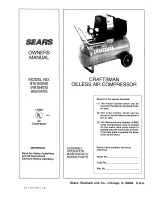
3.1.
Remove compressor from packaging and inspect for any shortages or damage. If anything is found to be
missing or damaged contact your supplier.
3.2.
save the packing material for future transportation of the compressor. We recommend that you store the
packing in a safe location, at least for the period of the guarantee. Then, if necessary, it will be easier
to send the compressor to the service centre.
3.3.
Confirm the mains voltage corresponds with the voltage shown on compressor data plate.
Wire in accordance with section 1.1. and check that the motor operates in the correct direction.
3.4.
The compressor should be operated on a flat surface, or one that does not exceed 15° either
transversely or longitudinally (fig.1), and should be in a position that allows good air circulation around the
unit.
3.5.
Confirm that the oil level is at the maximum mark on the sight glass (fig.2).
3.6.
When fully installed, start the compressor and ensure that everything is in good working order
before operational use.
Check the direction of rotation (see arrow on motor) to confirm
correct wiring of 3-phase plug.
2. INTRODUCTION & SPECIFICATIONS
The premier line heavy duty compressor range is suitable for garage, bodyshop and industrial applications. These units feature a heavy-duty
3-phase electric motor and cast iron cylinders to enable slower revving giving a longer life and higher performance. units have a 2-stage
compressor head with intercooler for maximum efficiency. fully automatic pressure switches help to keep line pressure at an optimum.
2.1.
Specifications
3. PREPARATION
fig. 2
fig. 1
All performance figures are ± 5%
IMPORTANT
Take care when selecting tools for use with the compressor. Air tool manufacturers normally
express the volume of air required to operate a tool in cubic feet per minute (cfm). This refers to
free air delivered by the compressor (‘air out’) which varies according to the pressure setting.
Do not confuse this with the compressor displacement which is the air taken in by the compressor
(‘air in’). ‘Air out’ is always less than ‘air in’ and so it is important that, before choosing equipment,
you study the ‘Free Air Delivery’ figures shown in the specifications chart, Section 2.
WARNING! Ensure that you have read, understood and apply Section 1 safety instructions and that
the unit is wired correctly.
4.1.
make sure the main switch (fig.3.1) is in position "O”, off, and the air outlet valves from the tank are closed.
4.2.
Plug the lead into mains supply and start the compressor by turning the main switch to “I”, ‘Auto’.
4.3.
make sure that pressure in the tank rises and that the compressor stops automatically when the max.
pressure value allowed - written on the plate and shown on the gauge (fig.3.2) - is achieved.
The compressor will now operate automatically. The pressure switch stops the motor when the maximum
tank pressure is reached and restarts it when pressure falls below the minimum threshold - approx. 2 bar
(29psi) less than the maximum pressure.
fig. 3
4. OPERATION
Model
Max. voltage/ Current
Piston
Maximum
Tank
Max.
Noise
Weight
Motor Phases
(A)
Displacement Free Air Delivery Capacity Pressure Level
(kg)
Output
(cfm)
(cfm)
(l)
(psi/bar) (dB.A)
(hp)
SA3015/55
5.5
415/3
8.5
20.4
15.5
150
160/11
77
91
SA3020/55
5.5
415/3
8.5
20.4
15.5
200
160/11
74
109
SA3027/75
7.5
415/3
11.6
31.0
25.0
270
160/11
80
180
• DO NOT
deface the certification plate attached to the end of the compressor tank.
• DO NOT
cover compressor or restrict air flow around the machine whilst operating.
danGEr! do not direct the output jet of air towards people or animals.
• DO NOT
operate the compressor without an
inlet air filter (see fig. 6).
• DO NOT
allow anyone to operate the compressor unless they have received full
instructions and adequate training.
WARNING!
the air tank is a pressure vessel and the following safety
measures apply:
do not tamper with the safety valve and do not modify or alter the tank in
any way and do not strap anything to the tank.
do not subject the tank to impact, vibration or to heat and do not allow
contact with abrasives or corrosive.
do drain condensation from tank daily, inspect inside walls for corrosion
every three months and have a detailed tank inspection carried out
annually. tank shell must not fall below the certified thickness at any point.
WARNING! If an electrical fuse blows, ensure that it is replaced with one of
identical type and rating.
•
When not in use, store the compressor carefully in a safe, dry, childproof location.
Original Language Version
sA3015/55, sA3020/55, sA3027/75 Issue: 2 - 21/10/09






















